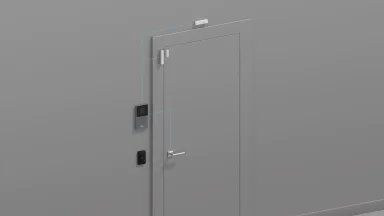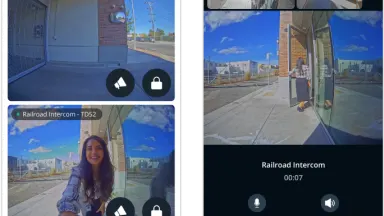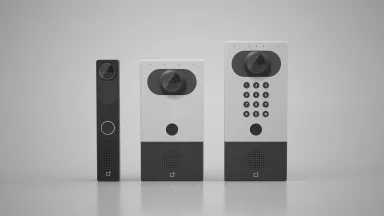A Modern Solution to Enhance Third Party Emergency Call Boxes and Blue Light Stations
We are excited to announce new updates to our Intercom offering in Command – an Emergency Intercom feature – to support emergency calling and call for aid scenarios. When combined with our Video Security and Connectivity offerings, organizations can now transform their blue light emergency phones into robust, multi-functional security stations.
A Critical, Yet Outdated Fixture
Why Blue Lights Remain Critical Today
In an era where nearly everyone carries a smartphone, the relevance of blue light emergency phones is often questioned. However, these stations have stood the test of time and remain an important fixture in large parking garages or higher education and healthcare campuses.
While personal phones may fall short in an emergency, blue light stations offer a reliable alternative. First, unlike cell phones, blue lights are rarely at risk of being lost, low on battery, or out of signal range. Second, calls from blue light phones go directly to campus security or to appropriate emergency responders. By contrast, someone using a cell phone may not know the correct authority to contact or the fastest way to reach them. Lastly, each blue light is fixed to a known location, helping responders to arrive promptly without callers needing to explain where they are.
Blue lights are a powerful visual reminder to stakeholders – like parents and students at universities – that campus security is taken seriously. 90% of students at the University of Delaware, for example, have stated that the presence of blue light stations makes them feel safer.
Not only do these stations put stakeholders at ease, but they can also deter crime. Rice University, for example, saw on-campus burglaries plummet by 68% after blue lights were installed. Increasingly, blue light stations are also being used beyond emergencies, offering callers assistance with directions, accessibility support, and general inquiries.
Challenges with Existing Deployments
While blue light stations offer clear benefits, many existing deployments face challenges due to aging infrastructure and outdated technology.
Many blue light stations were installed years ago and may now be prone to malfunctioning or failure. Moreover, the older technology in place often lacks video context and relies on outdated phone lines with unreliable caller ID. Maintaining these deployments is also no easy feat - oftentimes the only way to know if the system is working is to have people walk around campus to place test calls.
A Modern Solution
By integrating new technology, like video intercoms, security cameras, and back-up connectivity, organizations can improve call responses, enhance system reliability, and transform their third party blue light stations with valuable security assets.

Replacing audio-only call boxes with a Verkada video intercom equips response teams with valuable visual context to assess situations more effectively. Adding a multi-sensor camera further enhances visibility and provides additional insights. Teams can access an integrated video feed during calls through Verkada applications like Command or Desk Station, with traditional SIP phones available as a back-up in case of internet disruptions.
Identifying issues with call boxes and intercoms no longer needs to be so cumbersome. Security and maintenance teams can receive automated alerts if an intercom is tampered with or goes offline. And, instead of visiting each intercom in person to test functionality, teams can remotely diagnose and troubleshoot devices through Verkada Command. Additionally, organizations can enhance reliability by integrating a Cellular or Wi-Fi Gateway, which offers backup connectivity if a blue light station experiences network disruptions.
With integrated Verkada functionality, an organization’s blue light station can serve purposes beyond emergency call response. The intercom’s built-in camera, along with additional context cameras, provides new ongoing visibility into areas that may have previously been inaccessible or obscured. Cutting-edge camera analytics can trigger automated alerts for scenarios like unusual loitering or identifying persons of interest, such as frequent prank callers. Teams can further deter unwanted activity by using the intercom’s talk-down feature, even without a call being placed. Additionally, in case of evacuations, the intercom’s built-in badge reader can function as a mustering point for roll calls.
New Updates to Intercom in Command
Organizations can now easily configure intercoms for call for aid scenarios using the new “Configure as Emergency Intercom” option in the Settings tab of Command. This mode unlocks several key features designed to enhance emergency response. Calls can now last up to two hours, extending beyond the previous five-minute limit. To boost reliability during internet disruptions, organizations are prompted to set up a SIP extension for redundancy.

For campuses using intercoms for both entry management and emergency calls, emergency calls are distinctly labeled and prioritized in Command, designed to stand out from other intercom activity. If a receiver is managing multiple incoming calls, emergency calls automatically take precedence by going to the top of the list. Additionally, teams can filter to emergency call events in the Global Events and Reporting tabs for streamlined tracking and analysis.
Lastly, regardless of an intercom’s configuration, organizations can now view the date and time of the last call placed in the Settings tab—helping them determine if troubleshooting or maintenance is needed.
Availability
The above Intercom updates will be available to Command users on March 15, 2025.
Disclaimer: The Emergency Intercom feature in Command enables you to receive video and audio alerts from third party Blue Light Emergency towers or wall mounts in the platform. Customers are solely responsible for ensuring that their Blue Light Emergency towers or wall mounts comply with all legal and regulatory requirements, including the ADA accessibility standards. Verkada makes no representations or warranties regarding accessibility of emergency communication services or tools, and is not liable for accessibility compliance or functionality issues arising from customer’s feature configurations. In addition, Verkada makes no representations or warranties that the feature will be error free, and Verkada disclaims all liability for any harm or damages which may result from the feature’s failure to function properly. Customers are encouraged to make any necessary installation adjustments and incorporate appropriate signage that makes explicit disclosures regarding emergency use and/or notice.





